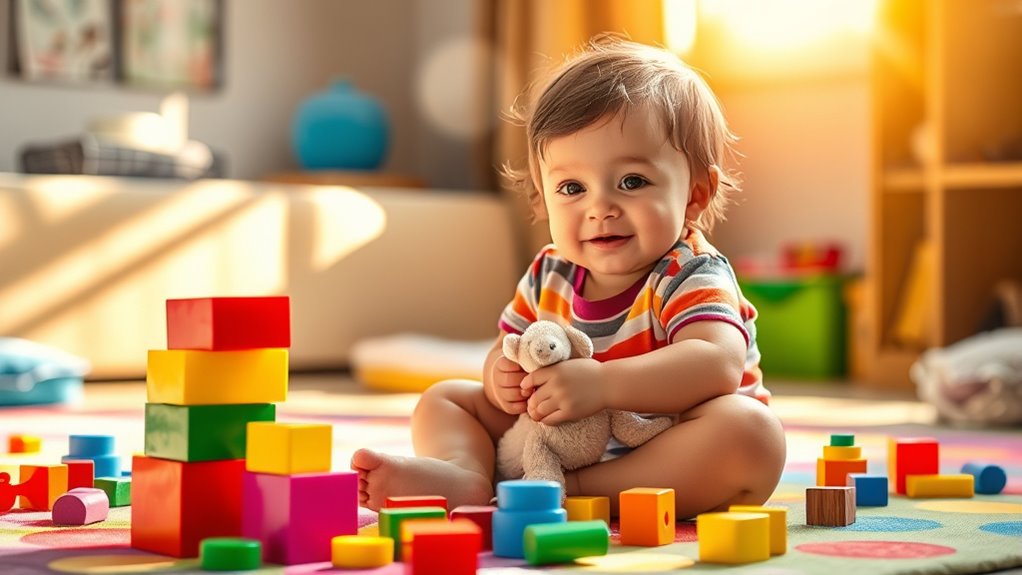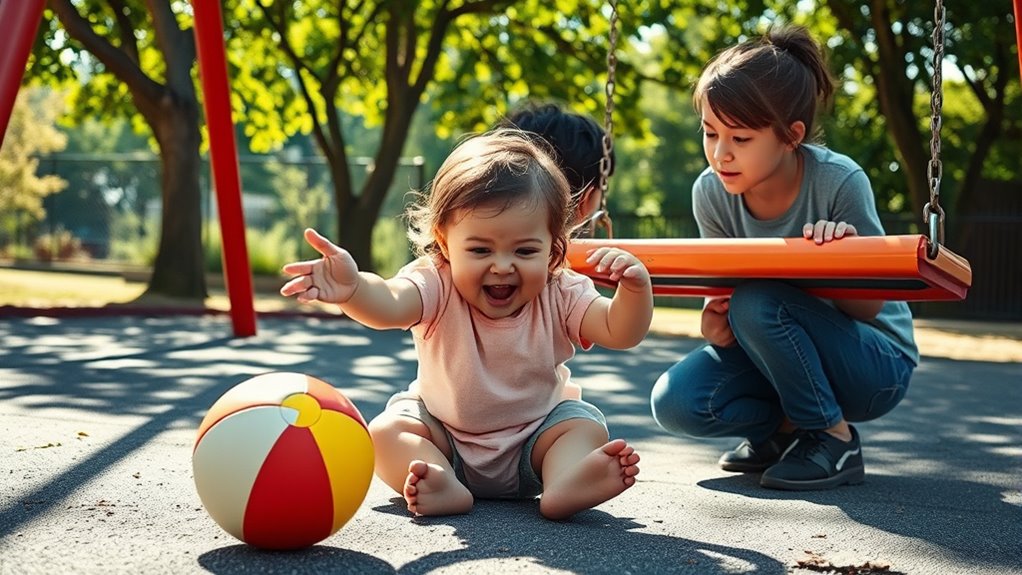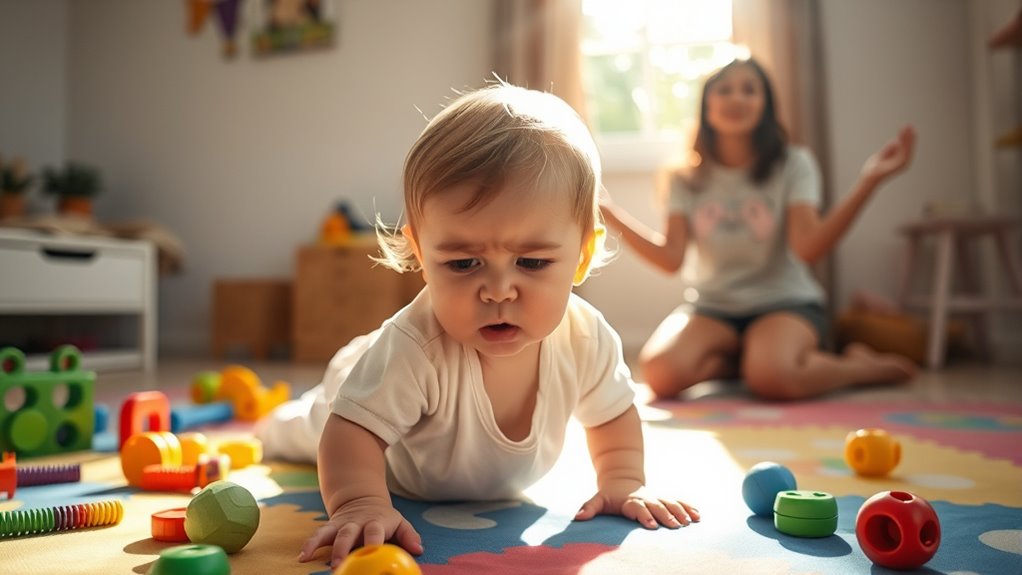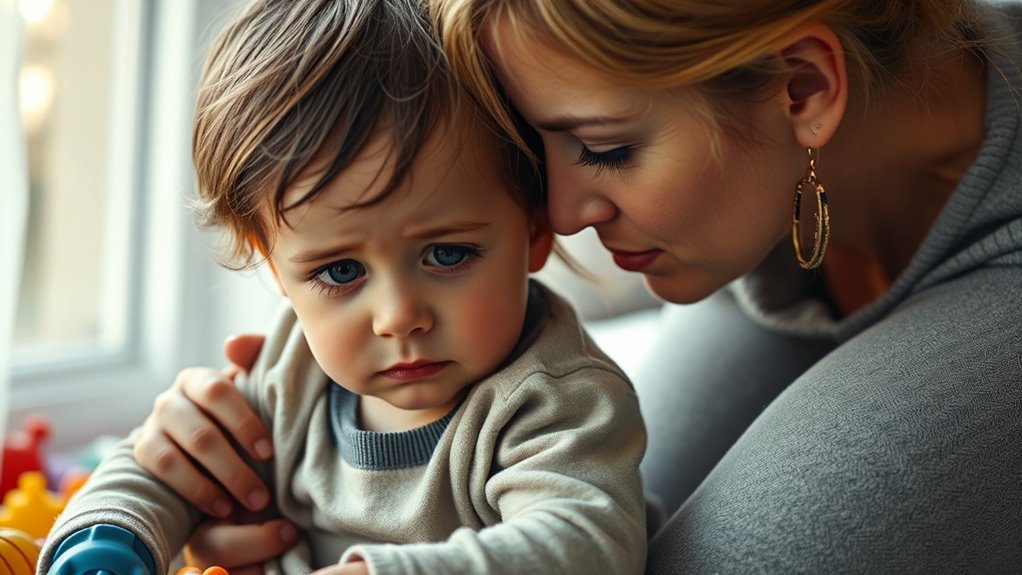Steering through the terrible twos means you’re witnessing your toddler’s rapid cognitive and emotional growth. They’re testing boundaries, leading to increased tantrums and frustrations. Your child may express intense emotions, making patience essential. By providing routines, clear boundaries, and choices, you can help them feel more in control. Encouraging language development and offering safe spaces for exploration can also reduce frustration. There’s so much more to understand about this stage that can make parenting easier.
Key Takeaways
- The terrible twos, occurring between 18 months and 3 years, involve tantrums and defiance as toddlers assert their independence.
- Cognitive development during this stage includes problem-solving skills and heightened curiosity, leading to exploration of their environment.
- Emotional challenges arise from limited language skills, causing frustration and tantrums; routines and communication can aid emotional management.
- Effective parenting strategies include maintaining calmness, acknowledging emotions, and providing choices to foster a sense of control and reinforce positive behavior.
- Educational toys play a crucial role by promoting cognitive growth, social interaction, and fine motor skills during this critical developmental stage.
Understanding the Terrible Twos: Definition and Timing

As your toddler enters the Terrible Twos, you might notice a surge in tantrums, defiance, and frustration. This phase typically begins between 18 months and 3 years, so don’t be surprised if it starts earlier than age two.
During this time, your child will often test boundaries, exhibiting behaviors like biting, hitting, and frequently saying “no.” These actions reflect their intense emotional growth and sensitivity, as they learn to assert their independence.
Your toddler’s testing of boundaries, including biting and hitting, showcases their emotional growth and budding independence.
It’s important to remember that the Terrible Twos are a normal part of development, helping your toddler learn about boundaries and self-expression.
Embrace this challenging phase as an opportunity for growth, both for you and your child, as they navigate their developing emotions and newfound autonomy.
Cognitive Development During the Terrible Twos

During the Terrible Twos, your toddler’s cognitive development takes center stage as they navigate the world around them. They explore cause and effect through trial and error, pushing boundaries to understand their environment.
You’ll notice their problem-solving skills evolving as they tackle simple tasks like dressing themselves. As preferences form, your toddler will express clear likes and dislikes, showcasing their growing cognitive understanding.
Their improved memory helps them recall past experiences, aiding in learning. Expect to see curiosity at its peak, driving them to explore more.
Engaging in interactive play and providing a safe environment encourages this exploration, enhancing their cognitive growth and understanding of the world.
Emotional Challenges Faced by Toddlers

While traversing the complexities of early childhood, toddlers face significant emotional challenges that can be both intense and overwhelming. They often struggle to express their feelings due to limited language skills, leading to frustration. This emotional intensity can result in tantrums, especially as they assert their newfound independence.
The quality of your relationship with them greatly influences their emotional development. Factors like parental mental health and environmental pressures can further heighten these challenges. It’s essential to approach these situations with empathy and understanding.
Establishing consistent routines and encouraging communication can help toddlers manage their emotions better. Remember, validating their feelings and creating a secure attachment will support their emotional growth during this tumultuous stage.
Common Behavioral Responses in Toddlers

Understanding the emotional challenges toddlers face can help you recognize their common behavioral responses.
Tantrums often arise from frustration, hunger, or fatigue, typically lasting 5-10 minutes. You might notice aggression, like hitting or biting, as they struggle with sharing or express frustration.
Tantrums can stem from frustration, hunger, or fatigue, often manifesting as aggressive behaviors during these challenging moments.
Defiance is common; saying “no” frequently is a way for toddlers to assert their independence. Attention-seeking behaviors, such as whining or interrupting, signal a desire for your focus.
Additionally, selective hearing can occur when they’re engrossed in activities or overwhelmed by sensory input. These behaviors reflect their limited communication skills and the natural impulse to explore boundaries as they navigate their rapidly changing world.
Understanding these responses can help you support them better.
Effective Parenting Strategies for Managing Tantrums

Since tantrums are a natural part of toddler development, managing them effectively is essential for both you and your child.
First, stay calm during the outburst; your composure can help de-escalate the situation. Acknowledge your child’s emotions to make them feel understood, and offer physical comfort if needed. Avoid reasoning mid-tantrum; instead, teach and discuss emotions when they’re calm.
To prevent tantrums, identify triggers like hunger or tiredness and maintain consistent routines. Provide simple choices to give your child a sense of control. Set clear boundaries and stick to your decisions to reinforce positive behavior. Additionally, understanding the importance of emotional support can be beneficial in creating a nurturing environment for your child.
The Role of Empathy and Patience in Parenting

Managing tantrums effectively sets the stage for deeper emotional connections between you and your child, making empathy and patience essential components of parenting.
By understanding that tantrums aren’t deliberate misbehavior, you enhance your empathy. Recognizing your child’s perspective helps you anticipate triggers and respond compassionately. Validating their emotions fosters emotional intelligence, encouraging them to empathize with others.
Patience further supports their emotional development, allowing them to learn self-regulation skills. When you model patience, you help them manage frustration and reduce meltdowns. This approach nurtures a secure attachment, promoting their emotional well-being.
Practicing active listening and naming emotions cultivates empathy, strengthening your bond and enhancing their social skills. Ultimately, empathetic and patient parenting leads to healthier relationships and happier children.
Encouraging Language Development to Reduce Frustration

To help your toddler express themselves better, encouraging language development is key to reducing frustration during their early years. Talk frequently with them, using daily activities to describe actions and objects, which expands their vocabulary. Incorporate gestures and facial expressions to enhance understanding.
Read aloud daily, choosing a variety of books and discussing pictures to boost engagement. Use open-ended questions to encourage detailed responses and practice two-sided conversations. Arrange playdates to foster social language skills, and engage toddlers in games that require verbal participation.
Label and acknowledge their emotions to help them manage feelings. Most importantly, reward their efforts to communicate effectively, creating a supportive environment for language growth. Additionally, understanding the importance of critical periods in language acquisition can further enhance your approach to their development.
Safe Spaces for Exploration: Reducing Frustration

Creating safe spaces for exploration is essential for your toddler’s development, as it allows them to learn about the world around them without constant restrictions. These areas should be free from hazards and filled with sensory experiences that encourage curiosity.
By designing a “yes space,” you enable independent play, which greatly reduces frustration and tantrums. Make sure the environment facilitates movement, with child-safe furniture and engaging tactile toys like Play-Doh.
Regularly check your home for hazards, install safety gates, and arrange furniture to create clear pathways. Consistent routines and opportunities for physical activity will also help manage frustration.
Long-Term Impact of Navigating the Terrible Twos

Finding your way through the challenges of the terrible twos can be a pivotal experience for both you and your toddler. Steering this phase effectively fosters emotional intelligence, helping your child learn to express and manage their feelings.
Your consistent support during tantrums builds their confidence and autonomy, laying the groundwork for future success. As you set clear boundaries and practice empathy, you enhance your child’s cognitive and social skills, promoting cooperation and problem-solving.
The positive relationship you cultivate now can lead to resilience and better emotional regulation as they grow. Ultimately, your approach during these formative years greatly shapes their ability to handle stress and steer challenges in adulthood, creating a stable and supportive environment for lifelong development. Additionally, engaging with educational toys can further facilitate your toddler’s learning and development during this critical stage.
Frequently Asked Questions
How Can I Tell if My Child Is Experiencing the Terrible Twos?
You can tell if your child’s experiencing the terrible twos by observing their behavior.
Look for frequent tantrums, stubbornness, and rapid mood swings. If they often test boundaries or say “no” to everything, that’s a sign.
You might notice physical outbursts like hitting or throwing things when frustrated.
Additionally, if they want to do everything independently, it’s a strong indication of this developmental phase.
Recognizing these signs can help you understand their needs better.
Are Tantrums Normal for All Toddlers During This Stage?
Yes, tantrums are completely normal for toddlers during this stage.
You’ll notice that they often struggle with expressing themselves and managing emotions, which can lead to outbursts. Factors like frustration, hunger, or tiredness can trigger these episodes.
It’s important to remember that these behaviors aren’t manipulative; they’re simply your child’s way of communicating feelings.
With patience and understanding, you can help your toddler navigate these challenging moments more effectively.
When Should I Seek Professional Help for My Child’s Behavior?
When your child’s behavior feels like a storm brewing, it’s time to seek professional help.
If you notice extreme tantrums, aggression, or persistent defiance that disrupts family life, don’t hesitate. You should consult a pediatrician if these behaviors persist despite your efforts.
Early intervention can improve behavior, strengthen your relationship, and reduce stress for everyone.
How Long Does the Terrible Twos Phase Typically Last?
The duration of this challenging phase can vary widely among children.
It typically starts around 18 months and may last until they’re 3 or even 4 years old. Some kids might breeze through it, while others could take longer.
Factors like your child’s temperament and how you manage their behavior play significant roles.
Consistency and patience on your part can help lessen the intensity and duration of this phase, making it easier for both you and your child.
What Are Common Misconceptions About the Terrible Twos?
You might think the terrible twos last only a year, but that’s not true; they can start earlier or even extend past three.
It’s easy to view a toddler’s behavior as manipulative, but often it’s just curiosity or frustration.
Not every child goes through the same challenges, and it’s essential to remember that toddlers aren’t deliberately disrespectful.
Embracing these misconceptions can help you approach this phase with a more positive mindset.
Conclusion
Maneuvering the terrible twos can be challenging, but understanding this stage is key. Did you know that around 75% of toddlers experience intense tantrums during this period? Recognizing that these behaviors are a normal part of development can help you approach each situation with patience and empathy. By implementing effective strategies and fostering communication, you can create a nurturing environment that supports your toddler’s growth and emotional well-being. Embrace this journey—it’ll pay off in the long run!









